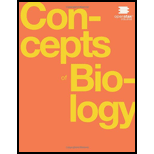
Concept explainers
Figure 20.12 Which of the following statements about the nitrogen cycle is false?
a. Ammonification converts organic nitrogenous matter from living organisms into ammonium
b. Denitrification by bacteria converts nitrates
c. Nitrification by bacteria converts nitrates
d. Nitrogen fixing bacteria convert nitrogen gas

Introduction:
Nitrogen cycle is a biogeochemical cycle that involves the movement of nitrogen between environment and living organisms. The nitrogen in atmosphere is converted to usable form by bacteria and this process is known as nitrogen fixation.
Correct answer:
The correct answer is option (c).
Explanation of Solution
Explanation for the correct answer:
Option (c) is given as nitrification by bacteria converts nitrates (NO3-) to nitrates (NO2-), which is incorrect because nitrification is the process of conversion of ammonia intro nitrites and then to nitrates by bacteria. Hence, option (c) is the answer
Explanation for the incorrect options:
Option (a) is given as ammonification converts organic nitrogenous matter from living organisms into ammonia. The statement is correct because ammonia is made either from the excreta of the living organisms or the decomposition of dead plants and animals. Hence, option (a) is incorrect.
Option (b) is given as denitrification by bacteria converts nitrates to nitrogen gas. The statement is correct because certain bacteria such as Thiobacillusdenitrificans can convert nitrates to free nitrogen. Hence, option (b) is incorrect.
Option (d) is given as nitrogen fixing bacteria converts nitrogen gas into organic compounds. The statement is true because nitrogen fixation is the process by which atmospheric nitrogen is converted into nitrates, nitrites or ammonia that can easily be assimilated by plants. Hence, option (d) is incorrect.
Nitrogen fixation is the process by which atmospheric nitrogen is converted into organic compounds that can be used by plants. Nitrification is the process of conversion of ammonia into nitrates through nitrites.
Want to see more full solutions like this?
Chapter 20 Solutions
Concepts of Biology
Additional Science Textbook Solutions
Biological Science (6th Edition)
Campbell Biology: Concepts & Connections (9th Edition)
Introductory Chemistry (6th Edition)
Biology: Life on Earth (11th Edition)
Microbiology: An Introduction
Human Anatomy & Physiology (2nd Edition)
- Explain how the hormones of the glands listed below travel around the body to target organs and tissues : Pituitary gland Hypothalamus Thyroid Parathyroid Adrenal Pineal Pancreas(islets of langerhans) Gonads (testes and ovaries) Placentaarrow_forwardWhat are the functions of the hormones produced in the glands listed below: Pituitary gland Hypothalamus Thyroid Parathyroid Adrenal Pineal Pancreas(islets of langerhans) Gonads (testes and ovaries) Placentaarrow_forwardDescribe the hormones produced in the glands listed below: Pituitary gland Hypothalamus Thyroid Parathyroid Adrenal Pineal Pancreas(islets of langerhans) Gonads (testes and ovaries) Placentaarrow_forward
- Please help me calculate drug dosage from the following information: Patient weight: 35 pounds, so 15.9 kilograms (got this by dividing 35 pounds by 2.2 kilograms) Drug dose: 0.05mg/kg Drug concentration: 2mg/mLarrow_forwardA 25-year-old woman presents to the emergency department with a 2-day history of fever, chills, severe headache, and confusion. She recently returned from a trip to sub-Saharan Africa, where she did not take malaria prophylaxis. On examination, she is febrile (39.8°C/103.6°F) and hypotensive. Laboratory studies reveal hemoglobin of 8.0 g/dL, platelet count of 50,000/μL, and evidence of hemoglobinuria. A peripheral blood smear shows ring forms and banana-shaped gametocytes. Which of the following Plasmodium species is most likely responsible for her severe symptoms? A. Plasmodium vivax B. Plasmodium ovale C. Plasmodium malariae D. Plasmodium falciparumarrow_forwardStandard Concentration (caffeine) mg/L Absorbance Reading 10 0.322 20 0.697 40 1.535 60 2.520 80 3.100arrow_forward
 Biology 2eBiologyISBN:9781947172517Author:Matthew Douglas, Jung Choi, Mary Ann ClarkPublisher:OpenStax
Biology 2eBiologyISBN:9781947172517Author:Matthew Douglas, Jung Choi, Mary Ann ClarkPublisher:OpenStax Concepts of BiologyBiologyISBN:9781938168116Author:Samantha Fowler, Rebecca Roush, James WisePublisher:OpenStax College
Concepts of BiologyBiologyISBN:9781938168116Author:Samantha Fowler, Rebecca Roush, James WisePublisher:OpenStax College
 BiochemistryBiochemistryISBN:9781305577206Author:Reginald H. Garrett, Charles M. GrishamPublisher:Cengage Learning
BiochemistryBiochemistryISBN:9781305577206Author:Reginald H. Garrett, Charles M. GrishamPublisher:Cengage Learning Biology: The Dynamic Science (MindTap Course List)BiologyISBN:9781305389892Author:Peter J. Russell, Paul E. Hertz, Beverly McMillanPublisher:Cengage Learning
Biology: The Dynamic Science (MindTap Course List)BiologyISBN:9781305389892Author:Peter J. Russell, Paul E. Hertz, Beverly McMillanPublisher:Cengage Learning





